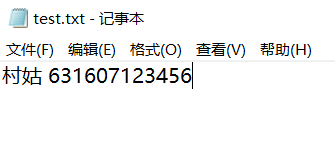【嵌入式】Opencv3.4.1繪製中文點陣
阿新 • • 發佈:2018-12-23
目標:利用opencv在圖片上新增文字
- 利用opencv自帶的putText就可以新增數字和英文
- 我們要求新增中文,達到以下效果
目錄
(一)Windows上繪製中文點陣
環境:VS2017+opencv3.4.1
- 建立空專案、新增原始檔Textimage.cpp、配置opencv環境(配置教程點這兒~)

- 思路:
- 從test.txt資料夾獲取將要錄入的姓名和學號,從txt資料夾獲取將要錄入的姓名和學號(test.txt內容如下圖)

- 從lena.jpg獲取將要顯示的背景圖片作為畫布
- 將中文和學號轉換為中文點陣字型檔中的點陣格式
(圖片為數字點陣asc-48x48的“0”、asci-15x16格式“0”、hzkf16x16格式“0”和漢字點陣格式倒置的“啊”)




- 利用opencv畫圖將漢字畫在畫布上
- 完成,執行結果:

原始碼
#pragma warning(disable:4786)
#pragma warning(disable:4996)
#include <stdio.h>
#include <stdlib.h>
#include (二)樹莓派繪製中文點陣
- 用teamviewer將
中文點陣字型檔檔案和圖片、之前在windows上建立Textimage.cpp和test.txt檔案打包傳到樹莓派上,如圖:


- 雙擊.cpp檔案進入修改程式碼檔案
- 新增目錄:#include <unistd.h>
- 修改2處 _getcwd(pbuf, 100); 把前面_刪掉
- 命令列模式進入當前目錄:
//.cpp目錄
cd /home/pi/test_wy/opencv_test/test4_Add_Chinese_Front
- G++編譯:
g++ Textimage.cpp -o Test `pkg-config --cflags --libs opencv`

- 得到Test可執行檔案
ls
./Test

原始碼
#pragma warning(disable:4786)
#pragma warning(disable:4996)
#include <stdio.h>
#include <stdlib.h>
#include <cxcore.h>
#include <highgui.h>
#include <unistd.h>
using namespace cv;
class ShowName {
public:
ShowName(char *filename);
ShowName(char *name, char* code);
~ShowName();
void openfile();//´ò¿ª×Ö¿â
void get_name_code();//»ñÈ¡ºº×ÖµÄÇøÂëºÍλÂë
void get_mat(unsigned char qh, unsigned char wh);//»ñȡͨ¹ýÇøÂëλÂëÀ´È·¶¨mat
void draw_name(int num);
void getasi(char incode[]);//»ñÈ¡Êý×ÖµÄASCIIÂë
void draw_code(int num);
void file_Runtodraw();
protected:
FILE* CONTERNER;//ÄÚÈÝÌṩÕß¼´Îļþlogo.txt
FILE* HZK24;//24×Ö¿â
FILE* ASI816;//ASCII×Ö¿â
unsigned char mat[72];
unsigned char num_mat[16];
char name_code_box[30];
IplImage* img;//ͼƬ
const int MAPSIZE = 24;//×ÖµÄsize
const int INTERSIZE = 5;//²åÈë¼ä¸ô
unsigned char name_code[3][2];
private:
char *Name;
char *code;
char *Name_code;
int sum_word;//×ÖÌåÊýÄ¿
int current_num;
};
//º¯ÊýÃû³Æ£º ~ShowName
//º¯Êý¹¦ÄÜ£º ÊÍ·Å¿Õ¼ä
ShowName::~ShowName() {
cvReleaseImage(&img);
fclose(HZK24);
fclose(ASI816);
if (CONTERNER != NULL)
fclose(CONTERNER);
img = NULL;
HZK24 = NULL;
ASI816 = NULL;
CONTERNER = NULL;
}
//º¯ÊýÃû³Æ£º ShowName
//º¯Êý¹¦ÄÜ£º ³õʼ»¯Îļþ
ShowName::ShowName(char *filename) {
if ((CONTERNER = fopen(filename, "rb")) == NULL)exit(1);
fseek(CONTERNER, 0, SEEK_SET);
fread(name_code_box, 30, 1, CONTERNER);
char *a = name_code_box;
Name_code = a;
sum_word = strlen(Name_code) - 2;
current_num = 0;
openfile();
}
//º¯ÊýÃû³Æ£º ShowName
//º¯Êý¹¦ÄÜ£º ³õʼ»¯
ShowName::ShowName(char *name, char* code) {
this->Name = name;
this->code = code;
this->current_num = 0;
this->sum_word = strlen(Name) / 2 + strlen(this->code);
openfile();
}
//º¯ÊýÃû³Æ£º openfile
//º¯Êý¹¦ÄÜ£º ´ò¿ª×Ö¿âºÍͼƬ
void ShowName::openfile() {
char pbuf[100];
getcwd(pbuf, 100);
strcat(pbuf, "/HZKf2424.hz");
char pbufASC[100];
getcwd(pbufASC, 100);
strcat(pbufASC, "/Asci0816.zf");
// ¶ÁȡͼƬ
if ((img = cvLoadImage("lena.jpg")) == NULL)exit(1);
// ´ò¿ª×ÖÌåÎļþ
if ((HZK24 = fopen(pbuf, "rb")) == NULL)exit(1);
//´ò¿ªasci8*16Îļþ
if ((ASI816 = fopen(pb

